

![]()
Traditionally, a priority of nearly every newly independent country is the foundation of a national airline. Ceylon (as Sri Lanka was known) was no exception in this regard. Even before independence from Britain was declared in February 1948, the wheels were in motion to equip Ceylon with its own flag-carrying airline.
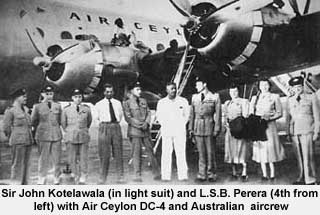 At
the helm was the dynamic Mr. (later Sir) John Kotelawala, then Minister
for Transport and Works. Keenly air-minded, Mr. Kotelawala did much to
foster private flying through the Aero Club of Ceylon in the 1930s, even
finding time to qualify for a Student Pilot's Licence. When war clouds
loomed, he took an active role in recruiting young Ceylonese men as pilots
with the Royal Air Force.
At
the helm was the dynamic Mr. (later Sir) John Kotelawala, then Minister
for Transport and Works. Keenly air-minded, Mr. Kotelawala did much to
foster private flying through the Aero Club of Ceylon in the 1930s, even
finding time to qualify for a Student Pilot's Licence. When war clouds
loomed, he took an active role in recruiting young Ceylonese men as pilots
with the Royal Air Force.
In 1947, with Independence a foregone conclusion, Kotelawala sought to raise the profile of the soon-to-be-independent nation by endowing it with its very own commercial air service. First, he appointed L. S. B. (Leslie) Perera to head the newly-created Department of Civil Aviation, and M. Chandrasoma, an experienced civil servant, as Perera's Secretary.
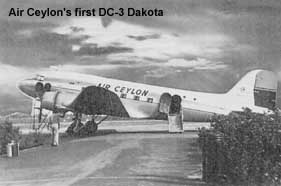 Next,
three war-surplus Douglas DC–3 Dakota aeroplanes were purchased. The DC-3s
were all named after queens – Sita Devi, Viharamaha Devi
and Sunethra Devi – a tradition which continued for some years.
Next,
three war-surplus Douglas DC–3 Dakota aeroplanes were purchased. The DC-3s
were all named after queens – Sita Devi, Viharamaha Devi
and Sunethra Devi – a tradition which continued for some years.
But the birth of the new airline was still a few months in the future. So the three aircraft, under the aegis of the Civil Aviation Department, were extensively used for pilot training and route proving duties. Joy flights promoted the notion of aviation as a viable means of local transport. The Dakotas also demonstrated their worth by operating emergency relief flights during the floods of August 1947.
In June 1947, at the suggestion of John Kotelawala, Viharamaha Devi flew to London to collect a valuable cargo of electoral registers for the coming elections. The historic, nine-day flight supplied further proof of what Ceylonese aviators, and the trusty DC–3, could accomplish.
On Wednesday 10 December, 1947, all this preparatory flying climaxed with the inaugural scheduled flight of the new airline, Air Ceylon. With Capt. Peter Fernando at the controls and a complement of 16 passengers, Sita Devi rose gracefully from Ratmalana's runway soon after 8 a.m. and headed for Kankesanturai (Jaffna). After a brief stop there, the Dakota proceeded to Madras, returning to Colombo by the same route later that day.
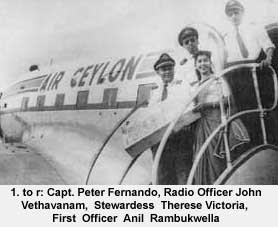 Assisting
Capt. Fernando on the flight deck were Capt. C.H.S. Amarasekera, First
Officer Emile Jayawardena and Radio Officer John Vethavanam. The honour
of becoming Air Ceylon's first air hostess fell to Miss. Mavis Wijeratne.
But this occurred through a twist of fate, as Miss. Wijeratne was employed
by Air Ceylon solely as a receptionist at the time.
Assisting
Capt. Fernando on the flight deck were Capt. C.H.S. Amarasekera, First
Officer Emile Jayawardena and Radio Officer John Vethavanam. The honour
of becoming Air Ceylon's first air hostess fell to Miss. Mavis Wijeratne.
But this occurred through a twist of fate, as Miss. Wijeratne was employed
by Air Ceylon solely as a receptionist at the time.
The air hostess designated to crew the inaugural flight took ill suddenly so Miss. Wijeratne was quickly substituted. After that single, inaugural flight, for which she earned a place in Sri Lankan aviation history, Mavis Wijeratne returned to her receptionist job, never to work as an air hostess again!
So began a proud tradition of commercial aviation in Sri Lanka which saw Air Ceylon achieve the distinction of one of the world's safest airlines, never recording a single passenger fatality throughout its 32-year history.
Before long another DC-3, Sri Lanka Devi, was added to the fleet. Scheduled services aside, the fledgling airline also operated a variety of charter flights to far-flung parts of the globe. In 1948 history was created again when the first aircraft with an all Ceylonese crew to land in Australia arrived in Sydney with a party of Ceylon Navy personnel.
The same year Capt. Rex de Silva commanded a special flight to Burma (now Myanmar) taking the sacred Sanchi Buddha relics for exposition in Rangoon, Mandalay and Akyab.
A series of Air Ceylon charters were also organised for Muslim pilgrims travelling to and from Mecca for the Haj season.
Soon, the regular route network extended to Trincomalee (China Bay), Trichinopoly, Bombay and Karachi. Flights to the latter three cities and Madras were, technically, international services, although described as regional routes.
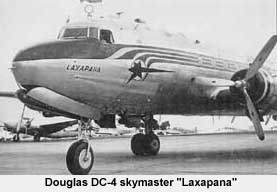 But
Air Ceylon achieved genuine international, long-haul status when it entered
into a partnership with Australian National Airways (ANA) in 1949. With
technical and managerial support from ANA, Air Ceylon began operating a
pair of Douglas DC-4 Skymasters from Colombo to London via Bombay, Karachi,
Tel Aviv and Rome. Later the service was extended to Sydney, calling at
Singapore and Jakarta.
But
Air Ceylon achieved genuine international, long-haul status when it entered
into a partnership with Australian National Airways (ANA) in 1949. With
technical and managerial support from ANA, Air Ceylon began operating a
pair of Douglas DC-4 Skymasters from Colombo to London via Bombay, Karachi,
Tel Aviv and Rome. Later the service was extended to Sydney, calling at
Singapore and Jakarta.
The DC–4 Skymasters, big brothers of the DC–3, were christened Laxapana and Ratmalana, taking their names from Ceylon's first hydro-electric scheme and the birthplace of Lankan aviation respectively.
After the association with ANA ceased in 1953, KLM Royal Dutch Airlines took over the Australian airline's share in Air Ceylon. In 1956, with a Lockheed Constellation leased from KLM, Air Ceylon resumed international flights on what became known as the "Sapphire Service", with Amsterdam a new destination.
The Constellation was dubbed Mahadevi, reviving the tradition of regal names. KLM updated the aircraft in 1958 with a larger version, the Super Constellation, which was named Soma Devi.
In November 1960, Soma Devi in turn gave way to a more modern Electra propjet, also supplied by KLM. The Constellation, Super Constellation and Electra all came from the Lockheed stable in Burbank, California-the same manufacturer that later produced the TriStar jetliners which formed the backbone of AirLanka operations for many years.
ln 1962 Air Ceylon parted company with the Dutch airline and turned to the British Overseas Airways Corporation (BOAC) for support on its overseas operations.
Using BOAC Comet 4 jetliners, Air Ceylon commenced international services to London via Karachi, Cairo and Rome, and to Singapore via Kuala Lumpur. Later, BOAC replaced the Comet 4s with Vickers VC-10s on Air Ceylon's international run.
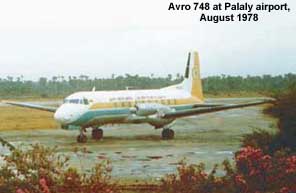 In
1964, Air Ceylon took delivery of its first, very own turboprop, a Hawker
Siddeley (Avro) HS 748. There was much excitement and fanfare at Ratmalana
airport when the brand-new Avro arrived with Captains P.B. Mawalagedera
and George Ferdinand in charge.It was followed in 1967 by another turboprop,
a Nord 262 from France. Unfortunately, the Nord proved unsuitable for local
conditions, and was disposed of two years later.
In
1964, Air Ceylon took delivery of its first, very own turboprop, a Hawker
Siddeley (Avro) HS 748. There was much excitement and fanfare at Ratmalana
airport when the brand-new Avro arrived with Captains P.B. Mawalagedera
and George Ferdinand in charge.It was followed in 1967 by another turboprop,
a Nord 262 from France. Unfortunately, the Nord proved unsuitable for local
conditions, and was disposed of two years later.
Air Ceylon made an even bolder leap into the aeronautical big time in 1969, purchasing a Hawker Siddeley Trident jetliner. The Trident served an expanded regional network which ultimately stretched to Sharjah in the Persian Gulf.
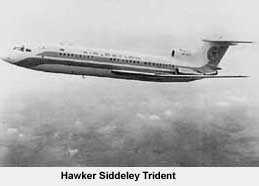 In
1972 Ceylon became the Democratic Socialist Republic of Sri Lanka. That
year also marked the termination of the Air Ceylon/BOAC liaison. Late in
1971 the Lankan carrier had already joined forces with French airline UTA.
In
1972 Ceylon became the Democratic Socialist Republic of Sri Lanka. That
year also marked the termination of the Air Ceylon/BOAC liaison. Late in
1971 the Lankan carrier had already joined forces with French airline UTA.
Becoming Air Ceylon's fourth international partner in 25 years, UTA provided a Douglas DC-8 jet for the long-haul services. Originally operated by UTA pilots with Sri Lankan cabin attendants, the DC-8 was subsequently bought outright by Air Ceylon and flown with a 100 percent Air Ceylon crew.
This purchase was applauded as a breakthrough in Air Ceylon's struggle to shed the shackles of foreign influence. Air Ceylon had, at last, come of age. As the last of the airline's faithful DC-3s were phased out, a second Avro 748 was bought.
Sadly, around this time, the first signs began emerging that all was not well with the national carrier. Whispers of mismanagement, corruption and financial instability were rife. Authorities in Europe impounded a DC-8 for non-payment of fuel bills, and staff morale plummeted when international services were suspended towards the end of 1977. A reduced domestic and regional operation soldiered on valiantly with the Trident and two Avros.
Then, one morning in September 1978, Air Ceylon suffered a cruel blow. One of the Avros, just back from a trip to Jaffna, was parked at Ratmalana when a bomb ripped the aircraft apart, reducing it to a charred, twisted hulk. Miraculously no lives were lost.
The surviving Avro and Trident struggled to maintain a semblance of an operation. Those two aeroplanes kept Air Ceylon alive even after AirLanka had taken wing on 1 September, 1979. But only just. The malady was terminal, and a once-proud Air Ceylon quietly faded into oblivion before 1979 had ended.
On a positive note, it would be fair to say that the heritage established by the men, women and machines of Air Ceylon, over a period lasting more than three decades, laid the foundation for the new carrier, AirLanka, which took Sri Lankan commercial aviation to newer, more exciting and technologically-advanced heights. But that's another story.
Continue to Plus page 11 * Medical Measures
Return to the Plus contents page
![]()
| HOME PAGE | FRONT PAGE | EDITORIAL/OPINION | NEWS / COMMENT | BUSINESS
Please send your comments and suggestions on this web site to
info@suntimes.is.lk or to
webmaster@infolabs.is.lk